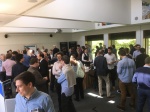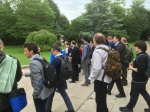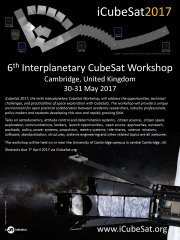iCubeSat Program 2017



iCubeSat 2017 was held over two days at the University of Cambridge, United Kingdom. Please note that the conference was an open conference and did not wish to discuss information restricted by ITAR or other export controls. U.S. citizens and permanent residents were responsible for ensuring that technical data presented was not restricted by ITAR and that ITAR controlled information was not discussed with non-U.S. citizens. Conference attendees ensured that their presentations and discussions comply with the relevant export controls of their own country, the United Kingdom and the European Union and those using the comments facility of the website are reminded that they should do the same.

Download the conference poster here.
Tuesday, 30th May 2017
| 8:45 | Registration | |
| 09:10 | Welcome Michael Johnson, Imperial / PocketSpacecraft.com Nadeem Gabbani, University of Cambridge |
|
| 09:30 | A.1.1. Deep Space CubeSats and nanosats at JPL Anthony Freeman, NASA/Caltech-JPL, U.S.A. |
|
| 09:50 | A.1.2. LUnar CubeSats for Exploration (LUCE) mission concept studies Roger Walker et al, ESA/ESTEC, The Netherlands |
|
| 10:10 | A.1.3. PIXE 2017: PocketSpacecraft Integrated eXploration Environment Michael Johnson, PocketSpacecraft, China/U.K./U.S.A. |
|
| 10:30 | A.1.4. NASA’s Cube Quest Challenge to Pick 3 Non-Government CubeSats to Compete at Moon and Beyond Jim Cockrell et al, NASA, U.S.A. |
|
| 10:50 | Break | |
| 11:20 | A.2.1. Lunar Meteroid Impact Observer (LUMIO): A CubeSat at Earth-Moon L2 Francesco Topputo et al, Politecnico di Milano, Italy |
|
| 11:40 | A.2.2. A road map for low frequency radio astronomy in lunar orbit using CubeSats Jeroen Rotteveal et al, ISIS – Innovative Solutions In Space, The Netherlands |
|
| 12:00 | A.2.3. Communication Relay and Navigation Micro Satellite for Lunar South Pole Landing Exploration Mission Lihua Zhang et al, DFH Satellite Co. Ltd, China |
|
| 12:20 | A.2.4 BIRDY-T iCubeSat to small body of the Solar System Daniel Hestroffer et al, IMCCE/Paris Observatory, PSL Research University, CNRS, UPMC, Univ. Lille, France |
|
| 12:40 | A.2.5 CubeSAT X-ray Telescope (CubeX) for Elemental Abundance Mapping of Airless Bodies and X-ray Pulsar Navigation Jaesub Hong et al, Harvard University, U.S.A. |
|
| 13:00 | Lunch | |
| 14:00 | A.3.1. Miniaturised Asteroid Remote Geophysical Observer (M-ARGO): a stand-alone deep space CubeSat system for low-cost science and exploration missions Roger Walker et al, ESA/ESTEC, The Netherlands |
|
| 14:20 | A.3.2. Flyby of 300 main belt asteroids by nanosat fleet using single-tether electric sails Pekka Janhunen et al, Finnish Meteorological Institute, Finland |
|
| 14:40 | A.3.3. CubeSat: A Candidate Mission Strategy for the Multi-Asteroid Target Exploration Peng Wang et al, DFH Satellite Co. Ltd, China |
|
| 15:00 | A.3.4. What is a rubble pile asteroid? A CubeSat Mission to find out Patrick Bambach et al, Max-Planck-Institute for Solar System Research, Germany |
|
| 15:20 | A.3.5. The CASTAway mission – opportunities for CubeSats in the asteroid belt Colin Snodgrass, The Open University, U.K. |
|
| 15:40 | Break | |
| 16:10 | A.4.1. Enabling satellites mass customisation reducing complexity, time and cost Jordi Barrera Ars et al, Open Cosmos, United Kingdom |
|
| 16:30 | A.4.2. Hermes – A Microgravity Facility on the ISS Kristen John, NASA JSC, U.S.A. |
|
| 16:50 | A.4.3. SERB, a nanosatellite dedicated to observe the Sun and the Earth Mustapha Meftah et al, CNRS, France |
|
| 17:10 | A.4.4. Team Miles: a CubeQuest deep space mission by citizen inventors Wesley Faler, Miles Space Inc., U.S.A. |
|
| 17:30 | A.4.5. Planetary CubeSats, nanosatellites and sub-spacecraft: Are we all talking about the same thing? Frank Crary, University of Colorado, U.S.A. |
|
| 18:00 -19:00 |
Social | One hour walking tour of Cambridge, the University and Colleges starting at Clare College and finishing at Darwin College in time for dinner. |
| 19:00 -21:00 |
Informal three course dinner at Darwin College (Please note that this is approximately a 10 minute walk from the conference venue and the GBP 32 cost of the dinner is not included in the registration fee) |
Wednesday, 31st May 2017
Please do not hesitate to contact committee@iCubeSat.org if you have any comments or questions.